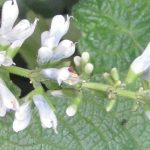Salvia bullulata: is a small bushy shrub, growing to approx 80 cm H. with turquoise flowers for a sunny sheltered position.

Salvia bullulata comes from Sth America, the turquoise flowers are very unusual.
Flowers: are small,tubular and turquoise with the tips of the hood and lobes being white, as if dipped in white paint. The tube is blue graduating to the turquoise colouring on the hood. The two side lobes and the lip of the bottom lobe are white but the throat is blue. All three lobes are the same length. The green bracts soon drop off after the flower opens.
The flower head evolves with the bottom whorls opening and tight pointed buds gradually opening.
Flowering in autumn and winter, it provides welcome nectar for bees and other pollinating insects during the colder months.
Calyces: and pedicels are green, with approx 8 flowers in a whorl around a green stem. The whorl begins with 4 flowers opening and 4 still in bud which open shortly after. The internodes between each whorls are long, so that each set of flowers can be visited by small birds and insects.
Leaves: are a mid green, rounded oval leaves, well veined, entire edges and often appearing in pairs.
Salvia bullulata has stems that elongate rapidly with new growth, but with regular tip pruning, the plant soon becomes shrubby. It has an open growth habit, allowing these long stems to drop down to the ground.
Plant in the front of a bed with smaller ground cover in the foreground, with colours such as yellows and pale pinks and other darker blues that will show off the turquoise flower colour.
S. bullulata loves a sunny protected position. It can be frost tender, so plant among other small shrubs that will protect it on those cold frosty mornings.
When most of the flowers have finished, clean out and cut back old dead and twiggy stems. This the time to cut back those long stems and neaten. Feed and mulch well to keep the root area cool in the summer months as S. bullulata hates the hot and dry, summer conditions. It prefers the cooler autumn season, growing well during the colder autumn and winter months.
Propagation: Tip cuttings are easily taken when cutting back those long stems.



